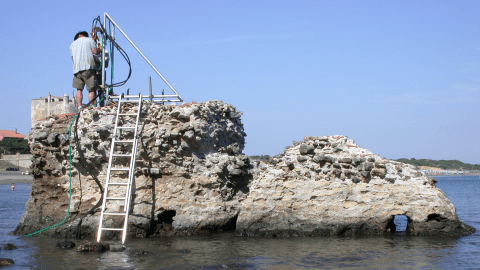Why Ancient Roman concrete lasts for millennia but ours crumbles in decades

Scientists resolved the mystery of why coastal structures built by ancient Romans 2,000 years ago are still standing. The concrete used by Roman builders in piers and harbors was made in such a way that it grew even stronger over time. Modern concrete, by comparison, tends to decay in just decades when exposed to saltwater. These findings could have an important role to play as many communities worldwide brace for rising sea levels.
Romans created concrete by mixing volcanic ash, quicklime and chunks of volcanic rock. Even though they figured out the ingredients, scientists still didn’t know the recipe. How did the Romans manage to make the concrete so long-lasting? The key turned out to be in the chemical reaction caused by the addition of seawater.
The Roman concrete was made to interact with its environment, as opposed to modern concrete which stays inert and gets damaged over time. Seawater is the reason why the mixture gets stronger. As seawater reacts with volcanic material, new minerals are created that reinforce the concrete.
Researchers, led by University of Utah geologist Marie Jackson, looked at the microscopic structures of Roman concrete samples by subjecting them to numerous spectroscopic tests and imaging techniques. The tests showed a rare reaction took place that spurred the growth of aluminous tobermorite crystals. Further geology detective work proved that the crystals were formed when seawater percolated through the little cracks in the Roman concrete, reacting to the mineral phillipsite, found in volcanic rock.
Jackson expressed her admiration for the genius of the Romans –
“They spent a tremendous amount of work [on developing] this – they were very, very intelligent people,” said Marie Jackson.
Structures like the Pantheon and Trajan’s Markets in Rome were also built with this kind of concrete.
Roman author Pliny the Elder, who wrote the ancient world’s famous science tract “Natural History” once praised Roman concrete, writing “that as soon as it comes into contact with the waves of the sea and is submerged becomes a single stone mass, impregnable to the waves.”
Indeed, that’s proven to be true. Jackson is now working on recreating Roman concrete using seawater in San Francisco. This work might prove useful in building longer-lasting and stronger sea walls – a fact of growing importance. A study by European scientists predicts the costs of new coastal reinforcements will reach as high as $71 billion per year during the 21st century. Without them, coastal flooding will lead to trillions of dollars in damages.
Check out this video from the University of Utah on how seawater strengthens Roman concrete:
Read the study in American Mineralogist.





